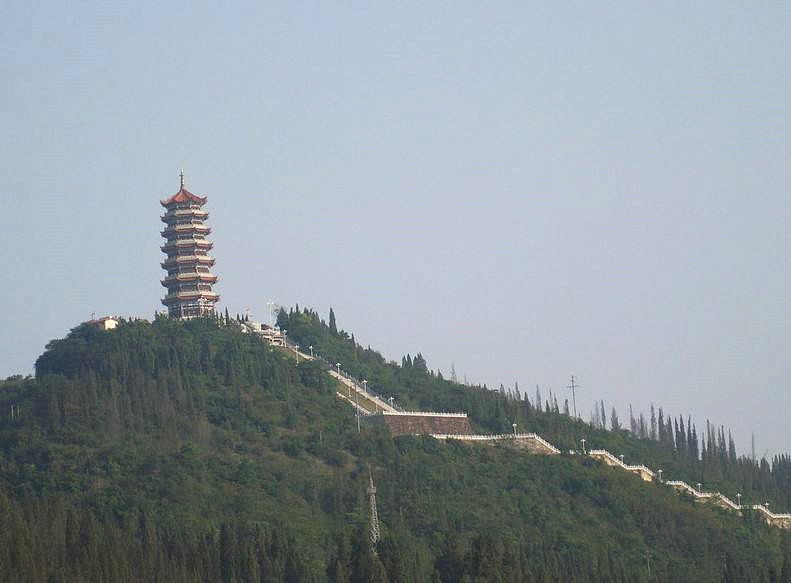
Wenbi Tower in Guangnan County, Wenshan
Chinese Name: 广南县文笔塔
English Name: Wenbi Tower in Guangnan County, Wenshan
Overview
Wenbi Tower is an 11-tiered hollow pagoda located on the summit of Santai Slope, 13 kilometers south of Guangnan County’s town center, near Basha Village. The tower faces the ancient city of Liantang, creating a picturesque and historic landscape. This architectural masterpiece, known as a Yunjiao (cloud angle) pagoda, stands as a significant cultural relic from the Qing Dynasty, embodying the aspirations for local cultural development and the cultivation of talents.
Architectural Features
- Height and Structure: The tower stands 36.8 meters tall, with a base height of 1.8 meters and a main tower height of 35 meters. The base is hexagonal, built with stone blocks, each side measuring 4.8 meters in width. The tower is constructed from blue bricks and tapers naturally as it ascends, culminating in a pen-shaped pinnacle.
- Design: Each level of the tower features decorative arched windows on the front and rear, with the seventh and tenth levels having notably deeper recesses. The meticulous design and solid construction have earned Wenbi Tower the title “The Tallest Pagoda in Southern Yunnan.”
Historical Significance and Restoration
The tower was originally built in the 30th year of the Daoguang Emperor’s reign (1850) during the Qing Dynasty. However, it suffered significant damage over time, particularly after being struck by lightning, which caused the partial collapse of the pinnacle and the expansion of cracks throughout the structure. The base also experienced extensive vandalism, with thousands of bricks removed, leading to concerns about the tower’s potential collapse.
From February to May 1982, a major restoration project was undertaken to preserve this important historical monument. During the restoration, a bronze statue of “Wenchang Dijun,” the deity of culture and literature, was discovered in a window of the seventh level, and a bronze statue of “Kuixing Bodhisattva” was found in the tenth-level window. These statues, standing 51 centimeters tall and weighing between 8.4 and 10.9 kilograms, were skillfully crafted and are now integral to the tower’s historical narrative.
Additional artifacts discovered during the restoration included five crystal crown jewels in red, yellow, blue, white, and black, as well as a broken wooden box containing a fragmented book, 100 deteriorated writing brushes, and an intricately carved circular stone inkstone. The inkstone, with a diameter of 8 centimeters, bore the inscription “Yan Tower Name Inscription” dated to the first year of the Xianfeng Emperor’s reign (1851), confirming the construction date of the tower.
To prevent further deterioration, glass bricks were installed in the windows to protect the interior artifacts from weather damage. A lightning rod was also added to protect the tower from future strikes, and semicircular concrete steps were built at the entrance to facilitate visitor access. A protective railing was erected around the tower, enhancing its grandeur and accessibility.
Cultural and Scenic Value
Wenbi Tower occupies the highest point of Santai Slope, offering expansive views of the surrounding mountainous terrain, lush with ancient pines and cypresses. The picturesque scenery of the Lianhua region unfolds to the north, with the distant view of Liantang City broadening the viewer’s perspective and evoking a sense of tranquility.
To enhance the cultural ambiance of the site, a three-bay, antique-style concrete archway inscribed with the words “Lianjun Scenic Spot” was constructed at the entrance of Santai Slope during the tower’s restoration. Additionally, two traditional-style pavilions named “Qingfeng Pavilion” and “Wanglian Pavilion” were built on either side of the hilltop, adding to the area’s scenic charm and making Wenbi Tower a more captivating destination.
Historical Recognition
Wenbi Tower is a relic from the Qing Dynasty. According to the “Gazetteer of Guangnan,” the tower was originally constructed during the Jiaqing Emperor’s reign by Governor He Yu and local residents. The discovery of the inkstone in 1982, however, accurately dates the tower to the early Xianfeng period (1851).
In 1993, Wenbi Tower was designated as a key cultural relic under provincial protection, underscoring its significance in Yunnan’s historical and cultural heritage.


 7 Days GolfingTour
7 Days GolfingTour
 8 Days Group Tour
8 Days Group Tour
 8 Days Yunnan Tour
8 Days Yunnan Tour
 7 Days Shangri La Hiking
7 Days Shangri La Hiking
 11 Days Yunnan Tour
11 Days Yunnan Tour
 6 Days Yuanyang Terraces
6 Days Yuanyang Terraces
 11 Days Yunnan Tour
11 Days Yunnan Tour
 8 Days South Yunnan
8 Days South Yunnan
 7 Days Tea Tour
7 Days Tea Tour
 8 Days Muslim Tour
8 Days Muslim Tour
 12 Days Self-Driving
12 Days Self-Driving
 4 Days Haba Climbing
4 Days Haba Climbing
 Tiger Leaping Gorge
Tiger Leaping Gorge
 Stone Forest
Stone Forest
 Yunnan-Tibet
Yunnan-Tibet
 Hani Rice Terraces
Hani Rice Terraces
 Kunming
Kunming
 Lijiang
Lijiang
 Shangri-la
Shangri-la
 Dali
Dali
 XishuangBanna
XishuangBanna
 Honghe
Honghe
 Kunming
Kunming
 Lijiang
Lijiang
 Shangri-la
Shangri-la
 Yuanyang Rice Terraces
Yuanyang Rice Terraces
 Nujiang
Nujiang
 XishuangBanna
XishuangBanna
 Spring City Golf
Spring City Golf
 Snow Mountain Golf
Snow Mountain Golf
 Stone Mountain Golf
Stone Mountain Golf















